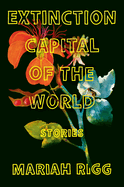
 Mariah Rigg, a Samoan Haole born and raised in O'ahu, presents Extinction Capital of the World, a masterful debut collection inspired by her own Hawai'ian history. In 10 interconnected stories, Rigg features multigenerational members--and their adjacents--of an extended family with overlapping Native and settler backgrounds.
Mariah Rigg, a Samoan Haole born and raised in O'ahu, presents Extinction Capital of the World, a masterful debut collection inspired by her own Hawai'ian history. In 10 interconnected stories, Rigg features multigenerational members--and their adjacents--of an extended family with overlapping Native and settler backgrounds.
Rigg begins with "Target Island," distilling a man's life forever affected by the U.S. government's 1948 bombing of Kaho'olawe. Rigg traverses through six decades when sexagenarian Harrison is back on Kaho'olawe, volunteering to make the island bomb-free, dreaming of a haven for the great-grandchildren he will never meet. His granddaughter, Lila, reappears in "Field Dressing," featuring Lila's father, Harrison's son, as he recalls Harrison's death while sharing a fishing trip with his hard-drinking friend Max. In "After Ivan," Max and his twin, Mason, are international kayaking champions until a horrific (maybe) accident ends their careers.
Max's daughter turns protagonist in "I Made This Place for You," as she considers leaving her island home--and, more importantly, her beloved grandmother Tutu--for a significant mainland opportunity at the San Francisco Museum of Modern Art. The descendants of Tutu's "hānai sister," Hina, include her son, Pono, and his estranged wife, Tori, who remains particularly bonded to Hina in "Poachers."
Pono and Tori's now-adult daughter, Kira, takes the spotlight in the titular final story, which opens and closes with a collective "we" that are the very islands: "We were here before this story's beginnings," concluding with "We let them go, into the future that awaited them." In between, Kira arrives home, seeking solace from her broken life once shared with nature documentarian Sam, who was introduced as a teen in "Dawn Chorus." Reconnecting with her extended family, particularly her father, Pono, offers Kira possible peace. "Scientists call Hawai'i the extinction capital of the world," Pono explains. "We had the most biodiversity... and each year, we lose the most of it." Kira's marine biology research enables a new generation of hope, her work instrumental in potentially saving the world's reefs.
Each of Rigg's stories easily stands alone as a succinct narrative but to parse together the web of tangled relationships yields gratifying rewards. To do so requires deliberate commitment--Rigg often eschews names and direct associations, relying on seemingly casual details as clever bridges between characters and stories. Throughout her meticulous fiction, she skillfully intertwines Hawai'i's complicated history of military abuse, missionary usurpation, colonial legacy, invasive tourism, ecological destruction. That intricate collage of people and events creates a wondrous literary gift. --Terry Hong
Shelf Talker: Samoan Haole Mariah Rigg makes a debut with an electrifying, interconnected 10-story collection highlighting both Native and settler residents of Hawai'i in Extinction Capital of the World.

